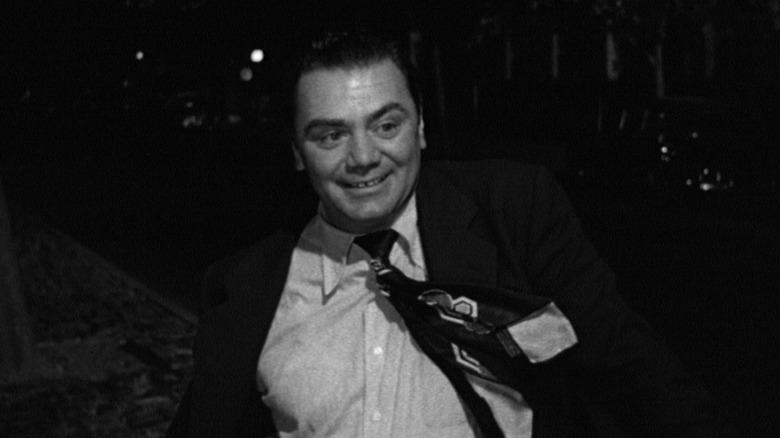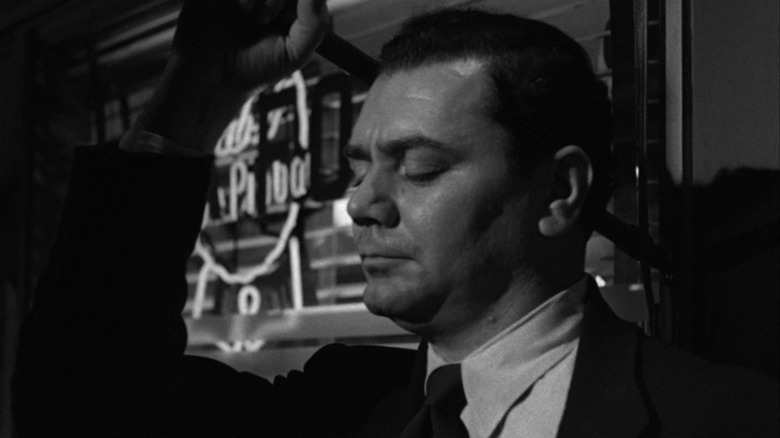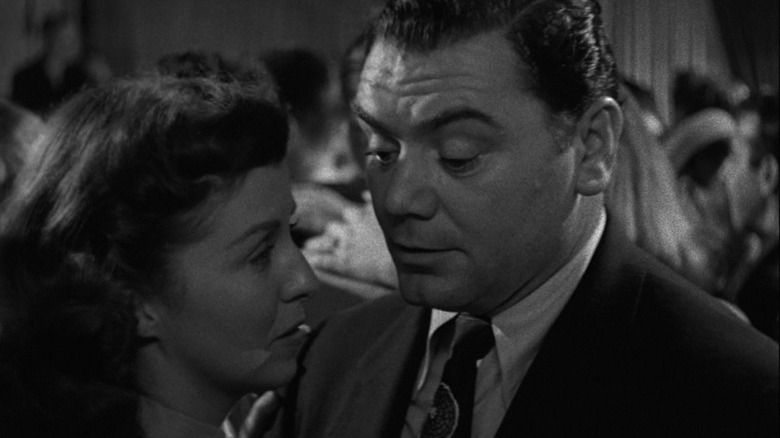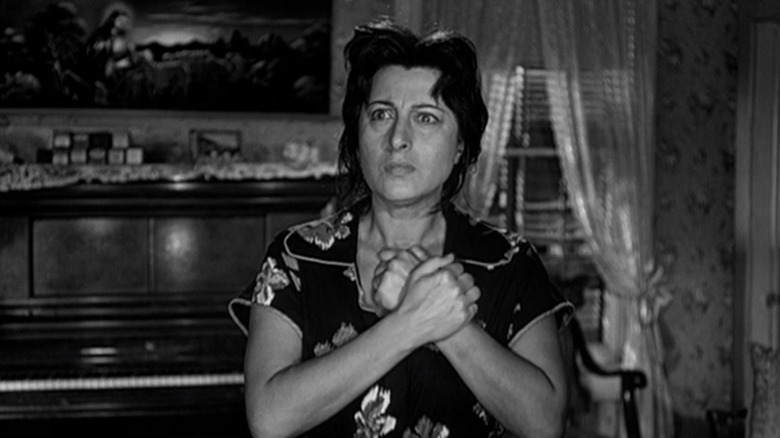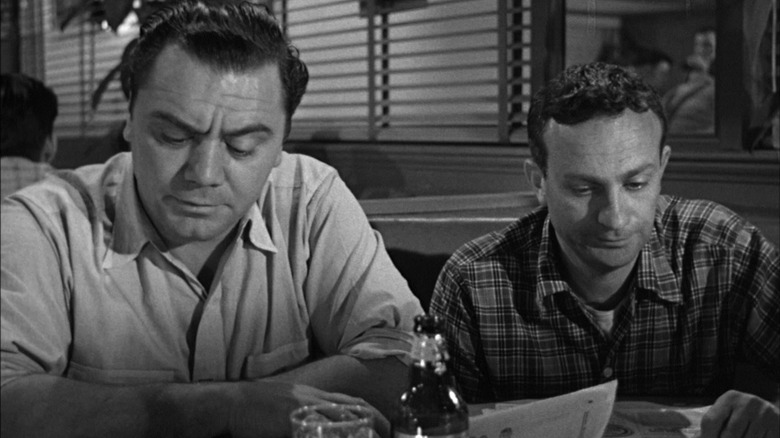Why Marty Rightfully Reigned Supreme At The 1956 Academy Awards
(Welcome to Did They Get It Right?, a series where we take a look at an Oscars category from yesteryear and examine whether the Academy's winner stands the test of time.)
Hollywood cinema of the 1950s was somewhat similar to today's film landscape. This decade was the first where movies truly had to compete with television, as they became incredibly prevalent in American households. What could the movies do to get people out of their houses and head to their local cinemas? Spectacle. You had sword and sandal epics, lavish Technicolor musicals, and the advent of CinemaScope showcasing a scope and scale that you weren't going to get on your small, black-and-white television.
The box office was burning up with the likes of "Samson and Delilah," "Quo Vadis," "The Ten Commandments," and "South Pacific." As opposed to today, these massive blockbuster successes didn't just rake in all the money. They received piles of Academy Awards. The Best Picture winners across the decade are a catalog of massive Hollywood entertainments like "The Greatest Show on Earth," "Around the World in 80 Days," "The Bridge on the River Kwai," and "Ben-Hur," capping off the decade.
Wedged right in the middle are two major outliers. The Best Picture of 1954 was Elia Kazan's "On the Waterfront," a relatively low-budget character drama from Columbia Pictures. The following year went even smaller, awarding the independently produced dramedy from Delbert Mann, "Marty." While "On the Waterfront" has remained a canonical American classic, "Marty" has mostly faded away from the popular consciousness, which couldn't be further from the fate it deserves. In retrospect, this picture stands as an example of the Academy not being seduced by wanting to continually pat itself on the back, making this one of the best aging Best Picture decisions in its history.
Simplicity is everything
Winning Best Picture usually means you are working on a grand scale, but "Marty" flies in the face of that. The titular Marty, played by Ernest Borgnine, is a man in his mid-30s who works as a butcher and still lives in The Bronx with his mother (Esther Minciotti) who constantly harangues him about getting married. Marty isn't opposed to marriage or companionship, but he finds it difficult to connect with women, being both incredibly shy and having a strong sense of self-pity due to his appearance. He figures his life will be spent working a nine-to-five job and then sitting at a bar after work with his buddy Angie (Joe Mantell), wasting away the rest of the day doing nothing.
That is until his mother twists his arm enough to head out to a dance club, where he meets the mild-mannered schoolteacher Clara (Betsy Blair), who has been abandoned by her blind date. The two find a connection in their shared experience of loneliness and end up having this wonderful evening together talking, dancing, and getting to know each other.
"Marty" has far more in common with your average Sundance film than one sweeping the major categories at the Oscars, taking home Best Picture, Director, Actor, and Screenplay. Ernest Borgnine is anything but a glamorous movie star, and the stakes of the movie basically amount to "Is he going to call that girl again?" It's funny, tender, and feels incredibly personal. After winning big at the Oscars, the New York Times wrote of its win:
"For the second year in a row, a black-and-white motion picture with no extra dimension other than quality won top recognition from Hollywood."
"Marty" was small and couldn't be less Hollywood in its creation, but that's what made it a source of beautiful humanity.
Escaping the studio fare
As is this case with films not featuring movie stars, "Marty" was a low-budget affair, costing $350,000 to make. Compare that to the only other film to receive both Best Picture and Best Director nomination, Joshua Logan's "Picnic," which cost nearly 10 times as much at $3 million. All of the other Best Picture nominees that year were well over $1 million as well (with the possible exception of "The Rose Tattoo," which I was unable to find budgetary information on, but Burt Lancaster's salary alone probably was a good chunk of change).
"Marty" did not have a massive Hollywood studio machine at its back. Yes, the movie was produced by Burt Lancaster, along with his agent and partner Harold Hecht, but this was them taking chance. Prior to this picture, every film they produced was a star vehicle for Lancaster. He had become such a massive name that this production company was the way he could maintain creative autonomy and appear in the films he wanted to. "Marty" was an experiment, using their clout to get something small made.
Ironically, "Marty" originated on television, as a teleplay by legendary scribe Paddy Chayefsky from 1953 that starred Rod Steiger. Lancaster and Hecht identified that this small-scale character piece from the small screen was ripe enough to expand and build upon for cinemas. Television was what Hollywood was trying with all their might to push against, but despite its TV origins, the Academy just couldn't deny that "Marty" delivered an enrapturing moviegoing experience. Money can't buy quality.
A night for character actors
Ernest Borgnine was a jobbing character actor. In 1955 alone, he appeared in six films, and outside of "Marty," his name only appeared above the title on the poster for one of them, getting third-billing for "The Square Jungle." On another, Nicholas Ray's "Run for Cover," his name isn't even on the poster. Leading roles with depth and complexity rarely are afforded to people who look like Borgnine, a squat, chubby individual. Borgnine never received another Oscar nomination before his death in 2012. That's how rare an opportunity this was for him.
All four acting winners that year would be classified as character actors. Best Actress went to Italian powerhouse Anna Magnani for "The Rose Tattoo." This wasn't a case of an international performer rising to prominence in Hollywood to be an exotic beauty. No, Magnani was about as authentic and raw an actor as you were to find at the time, rising to stardom in Roberto Rossellini's neorealist masterpiece "Rome, Open City." For "The Rose Tattoo," this was a middle-aged woman doing Tennessee Williams melodrama, whose first language isn't English, in a role specifically written for her because of her talent. It's unglamorous and un-Hollywood in every way.
Jo Van Fleet, who won Best Supporting Actress for "East of Eden," had never even been in a movie before. She was strictly a theatre actor prior to that win, but her stature in Hollywood didn't matter. All that did was the performance. The closest you get to a Hollywood acting winner that night was Jack Lemmon winning for "Mister Roberts," but this was before Lemmon was Hollywood's preeminent goofy leading man. Also, he mostly does comedies, which the Academy notoriously doesn't love. Every win wasn't about who was overdue but who deserved it.
Reclaiming Marty
Every year, film and media websites everywhere will publish rankings of every Best Picture winner in history, and Esquire put out one a couple of years ago that irked me. They ranked "Marty" at #63 and wrote:
"Haven't seen it. It's plonked here as a control, just a completely neutral non-film."
I was utterly depressed by this sentiment. Is this the true legacy of this film, something that we can just completely ignore? In reality, the lasting legacy of "Marty" basically amounts to one dialogue exchange. Marty and his buddy Angie are sitting next to each other in a booth. Angie asks, "What do you wanna do tonight?" Marty responds by saying, "I dunno, Angie. What do you wanna do?" They say this to each other a number of times, and it is basically a ritual between the two men. These lines have been repurposed and parodied all across media, and I bet a large number of you didn't know that this exchange originated here.
But "Marty" deserves so much more. It should be spoken about in the same breath as the other American classics of the era. "Marty" strives to deliver 90 minutes of simple, truthful humanity and wildly succeeds, giving voice to characters that mainstream film has ignored throughout its entire history. The film gets lost in the shuffle of history because it isn't operating on a grand scale, flaunting the old-school Hollywood glamor that cinephiles like myself love to absorb any chance we get. But it's precisely because it eschews those conventions that it makes its Oscar dominance even more remarkable, especially for the time. 67 years after its release, the emotional resonance of "Marty" is as potent as it ever was, and more need to help rescue it from the sands of time.
